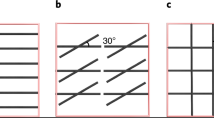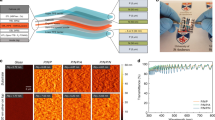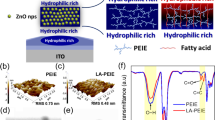Abstract
THE recent fabrication of light-emitting diodes (LEDs) from conjugated polymers1,2demonstrates the technological potential of this class of electronic materials. A variety of colours are possible, because the wavelength of luminescence emission can be chemically tuned during synthesis1–4. In addition, the mechanical properties of polymers suggest that light-emitting structures can be made that are more flexible than their inorganic counterparts, provided appropriate materials can be found for the substrate and electrodes. Here we report the fabrication of a fully flexible LED using poly(ethylene terephthalate) as the substrate, soluble poly-aniline as the hole-injecting electrode, a substituted poly(1,4-phenylene-vinylene) as the electroluminescent layer and calcium as the electron-injecting top contract. The structure is mechanically robust and may be sharply bent without failure. The LED is easily visible under room lighting and has an external quantum efficiency of about 1%. With a turn-on voltage for light emission of 2–3 V, the 'plastic' LED demonstrates that this unique combination of optical, electrical and mechanical properties can be used to make novel structures that are compatible with conventional devices.
This is a preview of subscription content, access via your institution
Access options
Subscribe to this journal
Receive 51 print issues and online access
$199.00 per year
only $3.90 per issue
Buy this article
- Purchase on Springer Link
- Instant access to full article PDF
Prices may be subject to local taxes which are calculated during checkout
Similar content being viewed by others
References
Burroughs, J. H. et al. Nature 347, 539–541 (1990).
Braun, D. & Heeger, A. J. Appl. Phys. Lett. 58, 1982–1984 (1991).
Burn, P. L. et al. Nature 356, 47–49 (1992).
Grem, G., Leditzky, G., Ulrich, B. & Leising, G. Adv. Mat. 4, 36–38 (1992).
Ojio, T. & Miyata, S. Polym. J. 18, 95–98 (1986).
Li, C. & Song, Z. Synth. Met. 40, 23–28 (1991).
Zhang, H. & Li, C. Synth. Met. 44, 143–146 (1991).
Cao, Y., Smith, P. & Heeger, A. J. Synth. Met. (in the press).
Cao, Y., Treacy, G. M., Smith, P. & Heeger, A. J. Appl. Phys. Lett. (in the press).
Wudl, F., Allemand, P. M., Srdanov, G., Ni, Z. & McBranch, D. in Materials for Nonlinear Optics: Chemical Perspectives (eds Marder, S. R., Sohn, J. E. & Stucky, G. D.) (683–686 American Chemical Society, Washington DC, 1991).
Stafstrom, S. et al. Phys. Rev. Lett. 59, 1464–1467 (1987).
Feucht, D. L. J. Vac. Sci. Tech. 14, 57–64 (1977).
Author information
Authors and Affiliations
Rights and permissions
About this article
Cite this article
Gustafsson, G., Cao, Y., Treacy, G. et al. Flexible light-emitting diodes made from soluble conducting polymers. Nature 357, 477–479 (1992). https://doi.org/10.1038/357477a0
Received:
Accepted:
Issue Date:
DOI: https://doi.org/10.1038/357477a0
This article is cited by
-
Photocatalytic Activity Enhancement of Au-Decorated Polythiophene/CeO2 Ternary Visible Light Photocatalyst Fabricated by Facile Hydrothermal and Photoreduction Routes
Arabian Journal for Science and Engineering (2024)
-
Integration of conducting polymers with MEMS lateral comb-drive resonator via electrodeposition for VOCs detection
Journal of Materials Science (2023)
-
Investigation of dielectric relaxation behavior, electric modulus and a.c conductivity of low doped polyaniline cadmium oxide (PANI-CdO) nanocomposites
Polymer Bulletin (2022)
-
Design of Polymer/Lithium Fluoride New Structure for Renewable and Electronics Applications
Transactions on Electrical and Electronic Materials (2022)
-
Two-Level Biomimetic Designs Enable Intelligent Stress Dispersion for Super-Foldable C/NiS Nanofiber Free-Standing Electrode
Advanced Fiber Materials (2022)
Comments
By submitting a comment you agree to abide by our Terms and Community Guidelines. If you find something abusive or that does not comply with our terms or guidelines please flag it as inappropriate.



